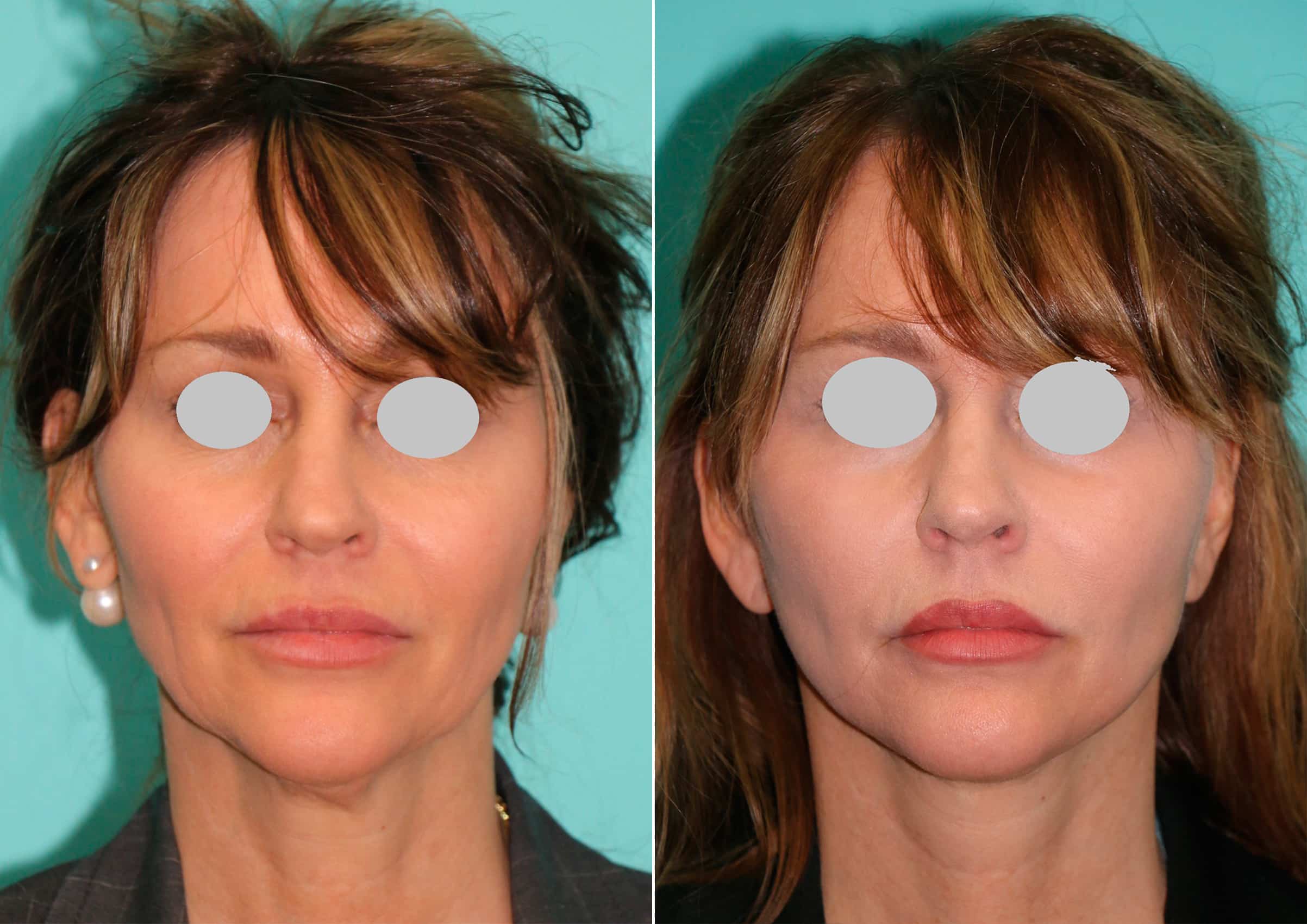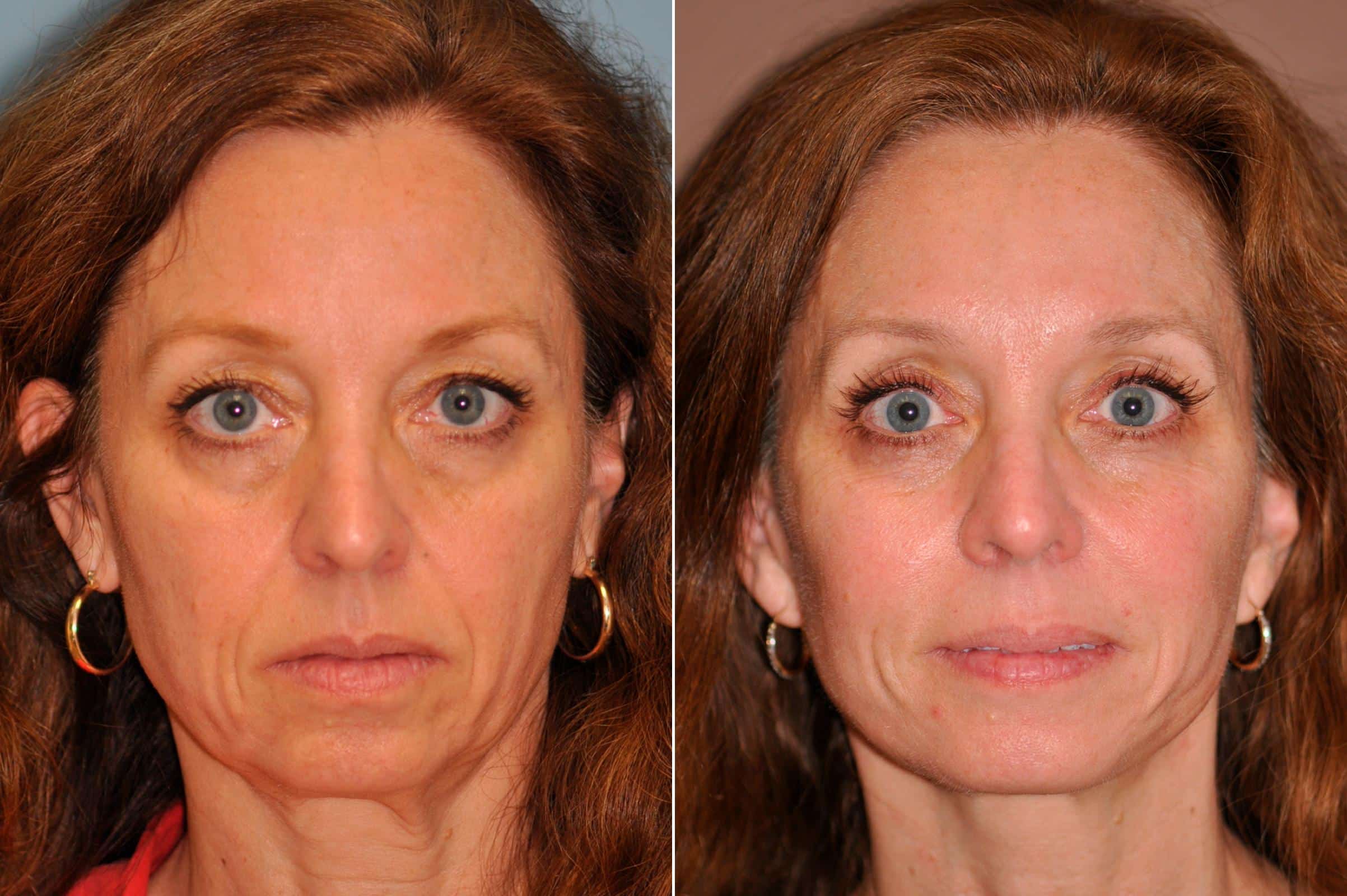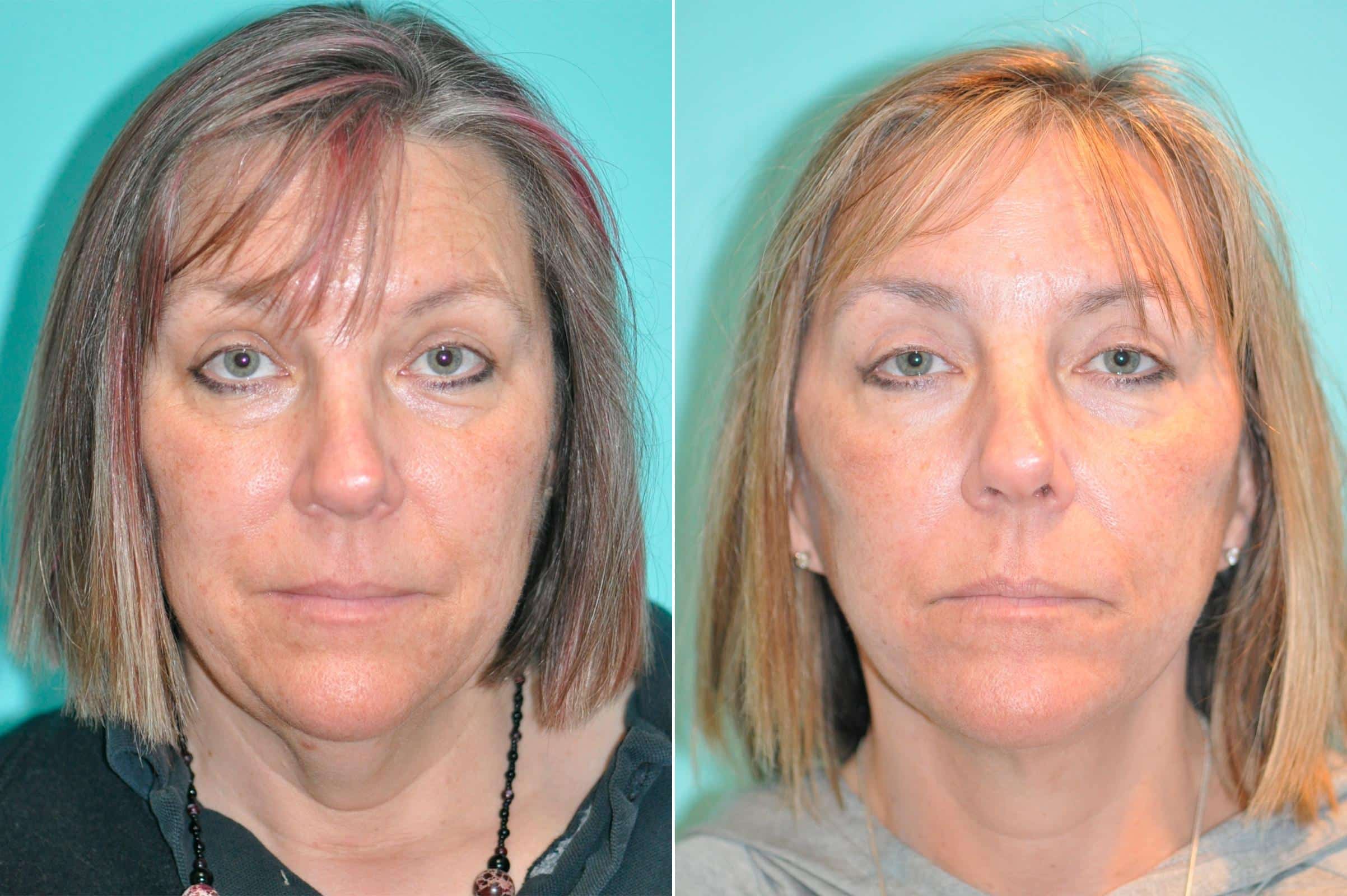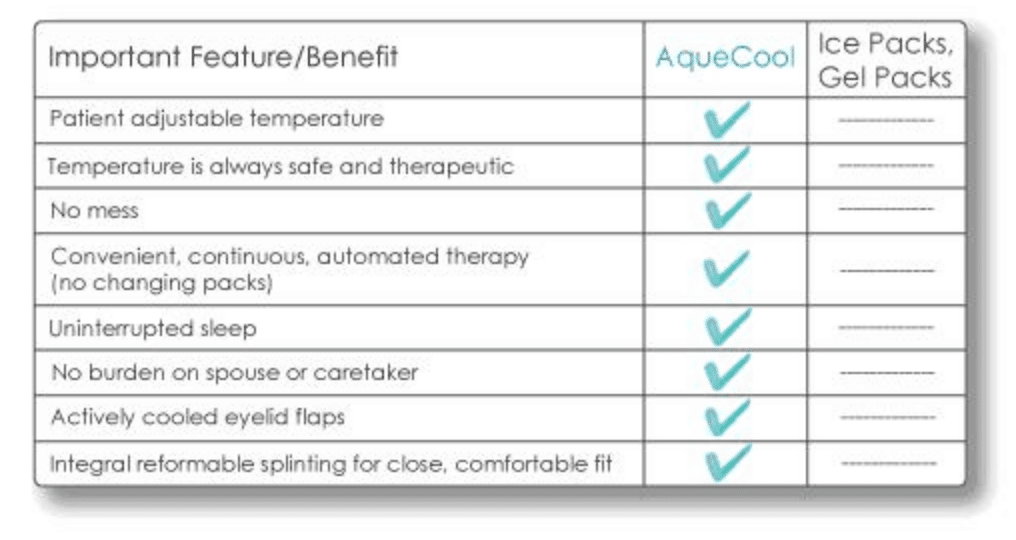Facelift Maryland, Virginia, and Washington D.C.
Embark on a journey of aesthetic excellence with The Naderi Center. Experience unparalleled artistry and precision for transformative beauty.
Enhance Facial Contours with Facelift Benefits
A facelift offers numerous benefits that can enhance your appearance and boost your confidence. This procedure addresses signs of aging, revitalizing your facial features for a more youthful look. It tightens sagging skin, reduces wrinkles, and restores facial contours, helping you achieve a rejuvenated and vibrant appearance. Here are more benefits:
Restored Youthfulness
Enjoy a renewed sense of youth as a facelift minimizes visible signs of aging, making you look and feel years younger.
Enhanced Self-Confidence
With smoother skin and a revitalized appearance, your self-confidence will soar, positively impacting various aspects of your life.
Long-Lasting Results
The effects of a facelift can last for several years, providing you with lasting improvements and delaying the natural aging process.



What Is a Facelift?
A facelift, which is also called rhytidectomy, is a type of facial plastic surgery focusing on addressing the natural aging effects on the face and neck. Aging causes a loss of skin volume, attributed to decreased collagen, elastin, and glycosaminoglycan production resulting in visible changes in facial appearance. This results in sagging skin, weakened muscles, and soft tissue descent, which can form jowls and blur the jawline. Volume loss in the cheeks and bone reduction can diminish facial support. The triangular facial focus in youth inverts into a squarer shape as jowls form and the midface volume decreases. Facelift surgery addresses these issues, restoring a more youthful appearance by tightening skin and muscles, and repositioning tissues.
Facelift Procedure Summary

Minor discomfort
General Anesthesia
Up to 4 hours
Hidden incisions are camouflaged along the hairline and inside of the ear for women or in front of the ear for men
1 to 6 months healing improves
2 weeks
2-3 weeks
Menu of Services includes pricing information
Facelift Expected Results
- Lift excess loose skin on the lower face that causes jowl formation
- Improve the appearance of a “turkey neck” caused by sagging skin around the neck
- Tightens and lifts the underlying muscle and soft tissue to restore the cheeks, jawline, and neck area to a more healthy and youthful position and contour
- Diminishes appearance of deep wrinkles
Ideal Candidates for Facelift
- Wants to improve appearance of jowls along the jaw and cheeks
- Has loose skin and excess tissue along the neck causing a double chin
- Has deep nasolabial folds or lines between the nose and corner of the mouth
- Has no medical conditions that will hinder surgical healing
- Is a non-smoker
- Has a positive outlook and realistic goals for what can be achieved
- Is in overall good health
Ideal Age for Facelift Procedure
Facelift surgery is typically associated with people in their 40s to 70s, although it can be performed on those outside this bracket. Facial aging can begin in the late 30s due to genetic and external factors like stress, sun exposure, and weight loss. Loose facial tissue can result from these influences.
Candidates for facelifts include individuals of any age experiencing tissue descent, skin loss, or changes in the jowls, cheeks, and neckline. The shift in cosmetic surgery is toward early intervention for gradual, natural results. Mini-facelifts, thread lifts, and non-invasive treatments like Ultherapy™ and SkinTyte™ help maintain youthful contours without immediate surgery.
Male Facelift surgery
A good facial plastic surgeon knows to address gender differences when performing facelift surgery. The aging concerns that males have are different from women’s concerns. Women are often looking to get rid of fine lines and wrinkles while men are generally more bothered by the loss of jawline definition. Furthermore, men often look for improvement to the lower face and neck rather than the full face. Another important difference between men and women for surgeons is where to hide incision lines. This is an important aspect of surgery for both men and women. Since men tend to wear shorter hairstyles and have more facial hair than women, plastic surgeons will have a slightly modified approach for their incisions when performing facelifts on men due to increased importance of hairline preservation.
Additionally, men experience a loss of muscle and skin laxity in the neck, sometimes paired with a fat deposit under the chin. Men with a weaker jaw and chin structure tend to develop these fat deposits at an earlier age, making them a great candidate for additional procedures such as submental liposuction and/or a chin implant.
Facelift Surgical Techniques
Facelift techniques vary based on the incision approach, target areas, and level of invasiveness. Surgeons make incisions along the ear contours and hairline, undermining the skin from fascia. The surgeon will tighten the cheeks, jawline, and neck, redrape the skin, and remove the excess skin. Thus, precise incision placement ensures natural-looking results.
Cutaneous Lift
A “skin-only” lift tightens only the skin, leaving the muscles and tissues untouched. It involves separating, stretching, and removing excess skin, and it has a lower risk for complications. This type of facelift is suitable for older patients with medical limitations. However, the results will not last as long, the scars will be more noticeable, and it only addresses surface skin laxity. Thicker scarring might occur due to the layer of skin that holds the incision. The results of a cutaneous lift do not last as long as other facelift techniques because of collagen loss.
“Although a cutaneous lift — or what most people know these days as a thread lift — has gained in popularity because of less cost as well as less downtime, I am personally not a fan because the results are not as impressive and long lasting as I would like them to be for my patients.”
—Dr. Shervin Naderi and Dr. Jessica Kulak, Aging Face Specialists.
SMAS Plication
The word “plication” means to fold or the action of folding. The “SMAS,” or “superficial muscular aponeurotic system,” is composed of deeper tissues of the face including the ligaments, fat, and musculature of the cheek. Unlike a skin-only facelift, SMAS plication consists of tightening the skin as well as its underlying tissues. The surgeon will often elevate and reposition the SMAS and platysma muscle to restore the youthful contours of the face and neck.
Once the surgeon has tightened this deeper tissue has been tightened, the surgeon will redrape the overlying skin and trim the excess skin to close the incision with minimal tension. Minimal tension at the closure of the skin is key to a thin and well-healed scar that is barely visible. This technique has longer lasting results, restores the SMAS to a more youthful position on the face, and better corrects the effects of aging. When done properly by a qualified facial plastic surgeon, the youthful results may last for 8-10 years.
Composite Facelift
The composite facelift is an advancement of the SMAS plication technique. This facelift is considered to be composite because it incorporates several elements of the face to reestablish true youthful characteristics of the face. Composite facelifts reposition the deep tissue layers of the SMAS. However, the key component of the composite facelift, which sets it apart from earlier techniques, is the addition of the orbicularis oculi muscle. This addresses the cheeks, jowls, and neck areas, and it includes a lift and tightening of the eye area as well.
Unlike more traditional facelift techniques that mainly focus on the horizontal repositioning of the facial skin and/or tissues, the composite facelift also takes into account the vertically descending effects of gravity on the face, giving an upward and horizontal tightening to facial tissues. The composite facelift typically has increased downtime and swelling. It is more invasive and has increased risk of complications
Deep Plane Facelift
A deep plane facelift is a more developed and invasive form of the traditional facelift. The deep plane facelift can better improve the nasolabial folds because it dissects deeper than the SMAS tissue layers, down to the underlying muscles. Since this procedure is dissecting underneath deep tissues of the face, it causes less tension on the more superficial layers of the skin, which can be beneficial for patients with thick skin and a heavier face.
Due to the depth of this procedure, it is important to go to a board-certified facial plastic surgeon who is experienced and regularly performs this technique. A deep plane facelift requires skillful and meticulous dissection of deeper tissue layers, which even in cases where experienced hands are performing the procedure, there is a much higher risk of permanent nerve damage than with other facelift techniques. One commonly seen complication is damage to the mandibular branch of the facial nerve, which can lead to permanent one-sided or bilateral lower facial droop. Due to the increased risk of complications with deep plane facelifts, many experienced surgeons as well educated patients decide to pursue a slightly less invasive facelift approach to minimize the incidence of potential complications.
Subperiosteal Facelift
A subperiosteal facelift is considered to be more invasive than a traditional SMAS lift. A subperiosteal lift separates all fat and muscle from the underlying bony structures of the face. A subperiosteal lift is a good choice for patients who also want facial implants. Since all facial tissues are lifted from the facial bones, the implants are nicely placed between them.
The most profound results of a subperiosteal lift are most noticeable on the upper two-thirds of the face, as this procedure involves a vertical lifting process. Since a subperiosteal facelift dissects down to the facial bones, this procedure typically has more involved downtime and lengthier recovery. Swelling can be quite significant, lasting weeks to several months.
Mid Facelift
The midface is commonly known as the area surrounding the nose, eyes, and even the corners of the mouth (the middle areas of the face). As we age and lose skin laxity, it is normal to experience sagging or descent in these areas. Some may find sagging of the eye, cheek, and mouth areas only, without experiencing sagging of the neck or jawline. In cases where there is very focused facial sagging, a mid-facelift could give a more youthful appearance, without the need to undergo a full facelift. The results of a mid-facelift are often subtle, and not long lasting.
Therefore, Dr. Shervin Naderi and Dr. Jessica Kulak rarely perform this procedure on its own. A mid-face lift is usually paired with additional procedures to attain more optimal results. Often an upper and lower blepharoplasty (eyelid lift) complements the results of a mid-facelift by also refreshing the eyes to a more open and well-rested appearance.
Facelift Incision Lines
In plastic surgery, discreet scar placement is essential for a natural look, allowing patients to achieve youthful results without obvious signs of surgery. Dr. Shervin Naderi and Dr. Jessica Kulak, facial plastic surgeons, excel in strategically making incisions within ear and hairline creases, preserving their position to reduce skin tension, which results in cleaner incisions and better scarring. They also address hair loss concerns near incisions by beveling them to promote regrowth, enabling patients to wear their hair up or back without visible scars.
Dr. Naderi and Dr. Kulak’s meticulous approach to facelifts and neck lifts involves placing incisions along the edges of the ear and behind the tragus cartilage for optimal camouflage, rather than in front of the ear where they are more noticeable. Proper techniques are used to minimize tension and prevent the tragus from being pulled forward, often involving the removal of fat and deep sutures under the skin. Their artistic eye for natural contours and facial rejuvenation consistently results in a more youthful appearance for patients, without any visible signs of surgery.
Mini Facelift
A mini-facelift surgery is essentially a less intense and less invasive version of a traditional facelift. It is a great option for patients who are experiencing mild signs of aging and facial sagging in the lower areas of the face. A mini facelift is typically done on patients in their 30s to young 50s who do not yet need a full facelift but could still receive improvement to their facial contours. Many people know the mini-facelift by other names such as the “s-lift” or the “weekend lift” for its incisional technique and speedy downtime. Incisions for a mini-facelift are typically from the ear around to the hairline, well hidden in natural contours. The term mini-facelift is also often loosely used for partial facelifts such as lower face only, midface only, etc.
Some may even refer to a mini-facelift as a procedure that primarily corrects the face with minimal correction to the neck, or as a procedure that primarily corrects sagging of the neck but not much of the face. The way the term is used may vary, so it is important to be very clear about which areas you are hoping to correct when going for a mini-facelift consultation. This will help the surgeon evaluate your specific anatomy and determine which kind of lift will give you optimal results.
Other Procedures Commonly Combined with Facelifts
For most individuals, the aging process affects a variety of different areas of the face at the same time.
Other common effects of facial aging may include:
- Drooping of the eyebrows
- Sagging, puffing, and/or heaviness of the eyelids
- Volume loss in the cheeks and temples
- Laxity of the neck
- Worsening skin texture, tone, and overall quality
- Enlargement of the nose and increase nasal droopiness
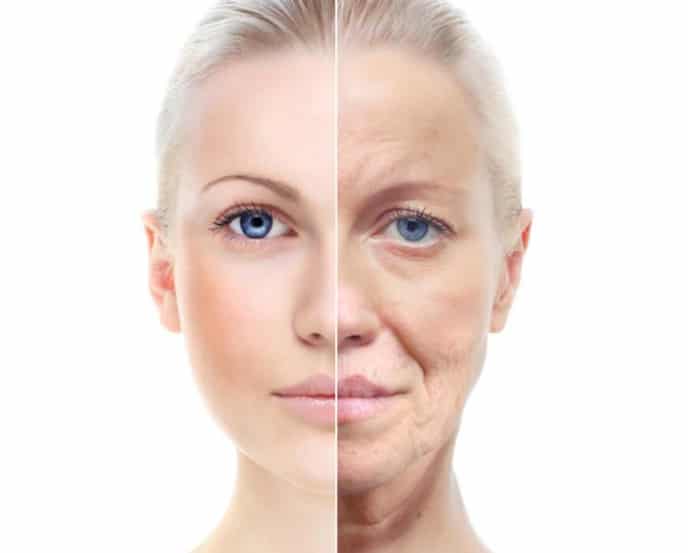
If any of these additional effects of aging are a concern, the surgeon can correct them at the same time as a facelift. Our facial plastic surgeon regularly performs multiple facial procedures during one surgery. She does this to reach a more complete youthfulness of the face so that no major signs of aging are left. For example, if a patient needs a facelift but is also experiencing significant heaviness and sagging of the eyelids that is contributing to a tired and aged appearance, it would be beneficial to correct this as well. During a thorough analysis and consultation, our board-certified facial plastic surgeon will discuss these topics and provide recommendations. facelift:
- Upper Blepharoplasty
- Lower Blepharoplasty
- Neck Lift
- Chin Implant Placement
- Fat Grafting
- Laser Resurfacing
- Brow lift Surgery
- Neck Liposuction
- Laser Resurfacing
Liquid Facelift
A liquid, or non-surgical, facelift is the restoration of a more youthful facial contour through the use of injectable dermal fillers and Botox. The injectable fillers can replace volume loss, lessen skin sagging by filling volume from within, and smooth fine lines, wrinkles, and folds. The liquid facelift is the latest trend of a non-surgical, non-invasive procedure with minimal downtime and low risk.
A liquid facelift is an in-office procedure in which the provider will inject fillers and Botox into specific areas to reduce the signs of aging. At The Naderi Center, we offer a topical numbing cream to ensure our patient’s comfort during the procedure. Downtime typically consists of minor swelling and bruising, but with the use of makeup, most patients can go about their daily routine per usual.
A liquid facelift may seem reasonable due to its low downtime, risk, and avoidance of an invasive procedure. However, it does come with drawbacks. A major drawback is the longevity of results. Although dermal fillers may last 1-2 years depending on the placement and quantity injected, our surgeons suggest routine dermal filler injections every 6-9 months to maintain the look. Furthermore, to maintain the results from Botox or Dysport, patients should come in for routine injections every 3-4 months. Patients should be aware of the continued maintenance required when opting for a liquid facelift.
Despite the ability of liquid facelifts to achieve great improvement, if your degree of skin laxity and facial aging is too severe, you may need more than just fillers and Botox to achieve the desired youthful look, including any of the more invasive facelift procedures. An experienced facial plastic surgeon will assess your degree of aging and help determine which procedure will be most beneficial to you.
Surgical/Standard Facelift vs. Liquid Facelift
| Surgical Facelift | Liquid Facelift |
|---|---|
| Longevity of results (~10yrs) | Longevity of results (6-9 months for dermal fillers, 3-4 months for Botox/Dysport) |
| More corrected result | Partially corrected result |
| Surgically invasive | Non-invasive |
| Higher risk | Low risk |
| Extended downtime | Little to no downtime |
Testimonial
“I should have had my facelift years ago had I knows the process would be so smooth.”
Cost of Facelift
A variety of factors determine the overall cost of your facelift procedure.
- Surgeons fee
- Anesthesia Fee: depends on length of procedure
- Hospital and Surgical Facility Fees: depends on length of procedure
- Post-Surgery Garments and Recovery Device: included with surgeon’s fee at The Naderi Center
- Pre-Surgical Medical Clearance and Lab Tests: usually covered by medical insurance
- Medication Costs: usually covered by medical insurance
- Follow-Up Visits: Included with surgeon’s fee at The Naderi Center
Facelift Consultation
Your facelift consultation with Dr. Naderi or Dr. Kulak in Maryland is an essential step in understanding your options and creating a personalized treatment plan. During this appointment, your facial plastic surgeon will evaluate your facial structure, skin elasticity, and overall aesthetic goals to determine the best approach for natural-looking results. They will explain the different facelift techniques, discuss recovery expectations, and address any concerns. Patients are encouraged to ask about scarring, downtime, longevity of results, and complementary procedures. This consultation ensures you have the knowledge and confidence to move forward with your facial rejuvenation journey.
At The Naderi Center, we believe we can improve the success of your facelift surgery with proper preparation. We go above and beyond to make sure that our patients are medically, emotionally, and physically ready for surgery.
Recovery After a Facelift
We will perform surgery at INOVA Fair Oaks Hospital, an ambulatory surgical center in Fairfax, Virginia, or Suburban Hospital and surgical center in Bethesda, Maryland. Patients will typically be discharged home from the hospital after a few hours in recovery to rest and relax. Many patients report little pain after facelift surgery. Minor discomfort is easily controlled with pain medication.
On average, recovery after a facelift takes about 10 days. The provider will remove bandages placed after surgery in the office the following day and will remove sutures after the first week. Swelling and bruising after a facelift are common and can take around 2 weeks to resolve. While the majority of the swelling will be gone by one month, swelling and incisions will continue to improve over the next 6 months. Most patients return to work after 2 weeks of recovery and can begin light exercise 3 weeks after surgery.
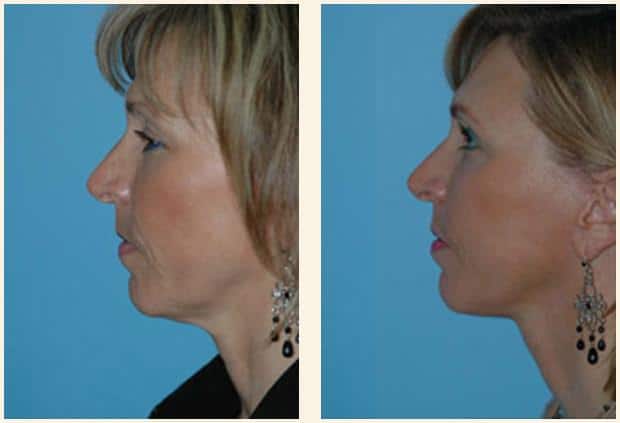
Aquecool Rapid Recovery System
Post-operative healing and care are of upmost importance when it comes to staying comfortable and safe, and ensuring a good result. This is why our surgeons, Dr. Kulak and Dr. Naderi, use the Aquecool Rapid Recovery System for every one of their facelift/neck lift patients. Aqueduct Medical has a top-of-the-line recovery system for patients during their post-operative healing to expedite downtime, reduce swelling and bruising, and manage discomfort. It is an advanced FDA-approved device that delivers safe and controlled compression and cooling to the operated areas.
There are two parts to the Aquecool Rapid Recovery System: the Aquecool Masque and the Aquecool Device.
The Aquecool Device is a portable and easy-to-use electric water cooling machine that maintains a water temperature between 50-65 degrees Fahrenheit (temperature may be specifically adjusted by the user). The Aquecool Device stays at its set temperature and is time-regulated to go on and off at appropriate increments to prevent tissue damage that can occur from over-icing. This device is then hooked up to the Aquecool Masque. The Aquecool Masque is a custom-fit, splint-like masque that is placed around the patient’s face and neck. When it is hooked up to the Aquecool Device, it circulates the temperature-controlled water through the masque to provide compression, comfort, and cooling.
Possible Dangers, Safety Measures, and Potential Issues of Facelift Surgery.
When undergoing any surgical procedure, there are always risks of complications. Although the chances of encountering a complication are low, patients should be aware of the possible complications that may come from a facelift surgery. Some possible risks of facelift surgery include:
- Hematoma – A hematoma is blood collection under the skin, which leaks from the blood vessels. This is one of the most common complications of facelift surgery and typically arises in the first 24 hours after surgery. Hematomas require medical attention and most often a surgical drainage of the blood collection.
- Scarring and Hair Loss – Most often scars from a facelift are concealed within the hairline and natural creases or folds of the ear. However, scars may become hypertrophic leading to a thickening and pigmentation of the incision line. Furthermore, this can cause either temporary or permanent hair loss along the incision lines. Routine steroid injections may improve hypertrophic scars and follicle transplantation may improve hair loss.
- Nerve Injury – Damage to underlying structures, such as nerves, may cause numbness, tingling, and weakened or even paralyzed movements of the face. Most of these side effects are temporary and resolve as the nerve endings reform. However, in rare cases permanent damage may occur.
- Skin Necrosis – Skin necrosis occurs when there is impaired blood supply to a certain region of tissues, which causes that region of tissues to die. Skin necrosis is a very rare but serious complication that requires medical attention. The risk of this complication is severely increased in smokers.
- Infection – Infection is always a possible complication of surgical procedures, as incision sites may become an entry point for bacteria. Signs of infection may include redness, swelling, drainage from the incision site, and fever. Infections may be treated with a course of antibiotics.
Many of the complications that may come from a facelift surgery can be controlled and treated with proper care, medication, or surgical correction. It is important to speak to your plastic surgeon about all possible complications that can occur before deciding on surgery. Strictly following your surgeon’s pre and post-operative care is imperative to achieving best results with the lowest risk of complications.
A Recognized Authority in Facelift Surgery
Dr. Shervin Naderi is not only a leading facial plastic surgeon but also an educator and thought leader in his field.
He co-authored the Rhytidectomy (Facelift) chapter in Facial Plastic and Reconstructive Surgery, one of the most respected and widely read textbooks among facial plastic surgeons worldwide.
His contributions to surgical education and innovation ensure that every facelift he performs reflects both artistry and evidence-based excellence.

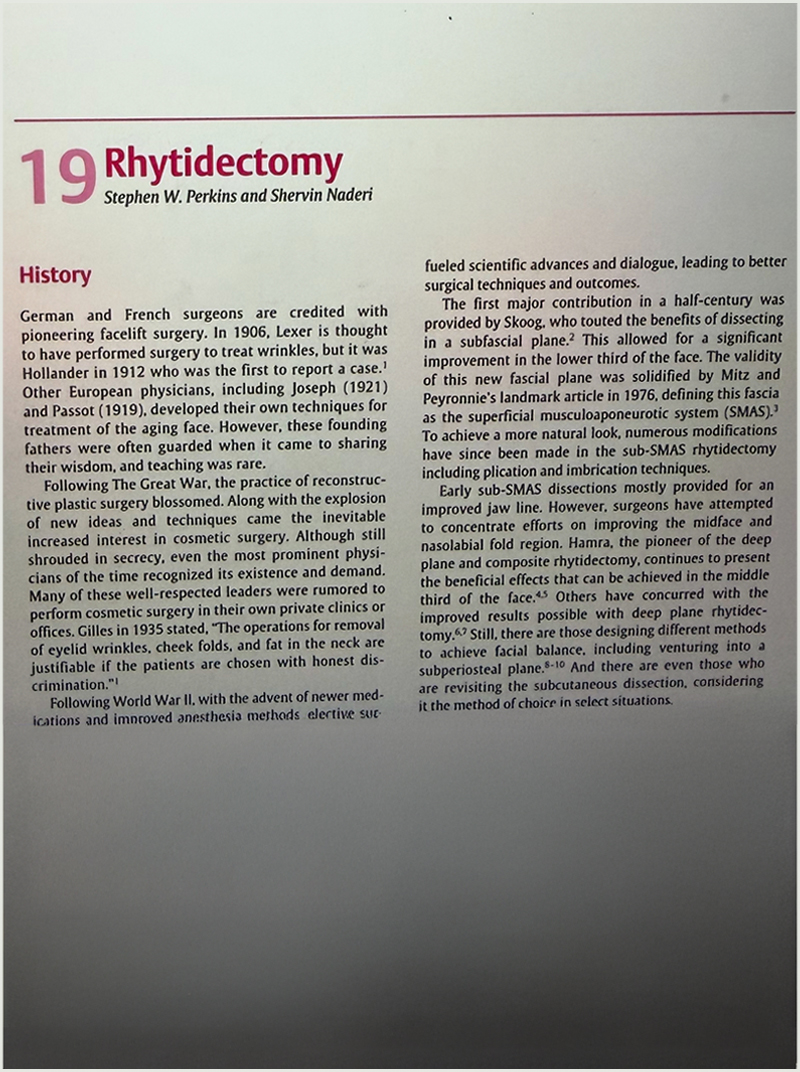
Facial Plastic Surgeon, Dr. Jessica Kulak & Dr. Shervin Naderi, Our Face Specialists
Dr. Kulak and Dr. Naderi approach each patient as an individual and try to develop a treatment plan that fits each patient’s goals and lifestyle. Everyone ages in a different way and at a different pace depending on a variety of factors. There is no set age that should guide your decision about when to pursue a facelift surgery. Our specialists offer many non-invasive treatment options to help reverse early signs of facial aging, such as fillers to replace volume loss or skin resurfacing to improve skin texture. However, surgery is the only true way to correct loose neck and cheek tissue in the face that causes the formation of jowls and the sagging skin appearance along the jawline.
Our surgeons utilize conservative but effective facelift surgery techniques to achieve a natural, long-lasting, and refreshed appearance to the face. Their goal is to restore a more youthful contour to the face without giving an overly tightened or “pulled-back” look. Your facial rejuvenation experts work with every patient to understand all of their individual goals and concerns in order to decide which procedures will give them the optimal outcome they hope for.
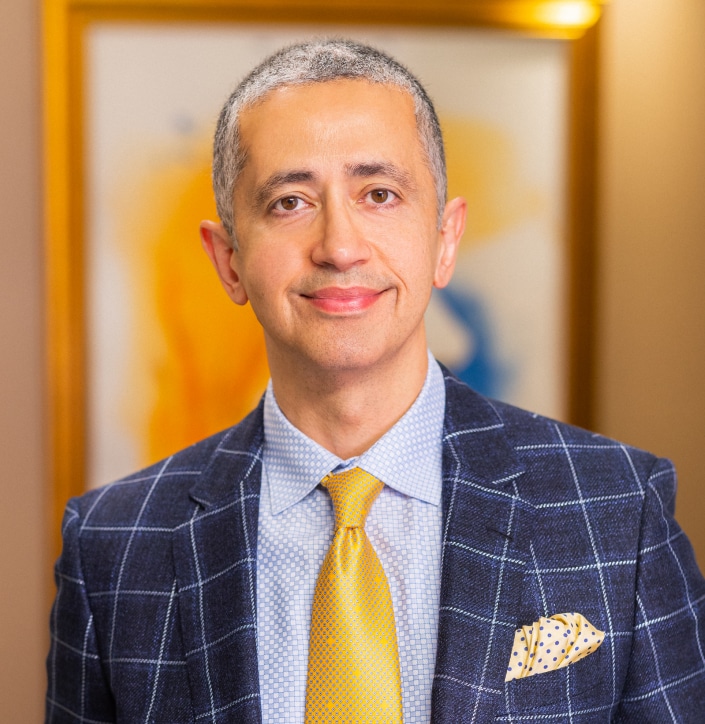

Known as a leader in cosmetic and plastic surgery procedures, The Naderi Center has been serving patients in the Virginia, Maryland, and Washington D.C. area for more than 10 years, with patients visiting from Virginia Beach and other parts of the country. The Naderi Center is known for being the source of physicians and surgeons that are specialized in their realm and scope of practice. Patient’s come to The Naderi Center when they want an expert on the procedure or condition they are trying to improve. Contact one of The Naderi Center’s two offices for more information, or to schedule your facelift consultation. A patient coordinator can be reached at our Reston, Virginia office at 703-481-0002 and at our Chevy Chase, Maryland office at 301-222-2020.
Facelift FAQs
Is facelift a potential option for me?
If you are unsatisfied with the degree of aging in your face and are experiencing significant skin laxity and/or jowling then a facelift is a good procedure for you. We also like our patients to be in good health and at a stable weight. Smokers must be able to quit for at least 2 weeks prior and 2 weeks following surgery.
Would I be able to have a facelift and CO2 Laser all in the same surgery?
Although it is not preferred to have a full face resurfacing and facelift done at the same time, it is not prohibitive when performed by an experienced surgeon. With that in mind, laser resurfacing around the lip lines and around the eyes during a facelift is commonly performed and does not hinder healing. It is the cheeks which surgeons must be extremely careful with when combining a laser resurfacing procedure with facelift surgery. In regards to extra swelling, a CO2 laser resurfacing does not significantly increase swelling when combined with face surgery.
How soon do the scars of a facelift heal and are they hidden?
The facelift scars are typically along the temporal tuft of the hair and a good surgeon will place them such that they are as hidden as possible. Scars can take up to one year to heal, so do not judge their appearance too soon after surgery. Our practice can also offer scar creams, which will aid in decreasing the appearance of the scars.
I just had a lower facelift, is it normal to be numb under my chin, neck, and around my ears? How long will this numb sensation last?
Numbness after a facelift is very common, especially around the incision lines. The numbness near the ear and chin reduces over the first 3-6 months post facelift. Some areas of numbness can be more stubborn and take longer to go away. In addition to numbness, patients may notice other abnormal sensations such as a “tingling” feeling or “pins and needles.”
My biggest fear is my family and friends finding out I have had ‘work’ done. I am worried that the scars from my facelift will be visible
One of the biggest fears patients have with cosmetic surgery is appearing like they have had “work” performed. Scars should be hidden in the creases and in the hairlines so that they are very difficult to locate. Hiding scars when possible is extremely important in cosmetic surgery.
Should I try to lose weight before my facelift?
Similar to other parts of the body, if you lose weight in your face the skin will become more lax and the appearance of hollowness and jowls will increase. If a facelift is performed and significant weight loss occurs after, it may leave the patient with more excess skin that would require another facelift procedure. For this reason, it is better to lose weight prior to a facelift rather after. Most doctors will typically recommend that patients are within 10 pounds of their ideal or stable weight. However, if there is a small amount of stubborn under chin fat, which a patient cannot get rid of, our facial plastic surgeon will often incorporate submental liposuction to assist with its removal and a better result.
What are the limitations of facelift surgery?
A facelift does not change the appearance of the skin. Fine lines, fine wrinkles, hyperpigmentation, age spots and skin texture will not improve with a facelift. Improving the overall skin quality and wrinkles typically requires a resurfacing procedure such as a chemical peel or laser resurfacing. The facelift procedure mainly addresses the lower portion of the face and neck. To significantly improve the upper portion of the face and eyes, adjunctive procedures such as a forehead lift or eyelid surgery may also be beneficial. Often times a facelift is combined with other facial surgical procedures as well such as skin resurfacing to give the most youthful and rejuvenated results to a patient.
What’s the typical duration of results from a facelift?
A facelift can “turn back the clock” on aging and may take 10 years off your appearance, but unfortunately it does not halt the aging process. Most patients will find that their rejuvenated appearance will last somewhere between 8-10 years. Although the results of a facelift are not fully permanent, by patients staying out of the sun and taking good care of their skin, they can prolong their surgical results.
Does a Facelift Address Skin Complexion?
A facelift addresses the laxity and sagging of the skin on the face and neck to create a more youthful contour. However, it cannot correct other skin issues such as fine lines, sun damage, melasma, blemishes, etc. without the addition of skin-complexion correcting procedures. It is important to not only lift and tighten the skin with a facelift procedure, but to also ensure the quality of the skin tone and texture as well. This is why many of those who undergo a facelift surgery will also opt for a deep laser resurfacing procedure to be done at the same time.
Our Board-Certified facial plastic surgeons, Dr. Kulak and Dr. Naderi, often perform a CO2 laser resurfacing procedure in conjunction with other surgical procedures in the operating room. They use the Active FX laser, one of the deepest penetrating ablative lasers on the market. The Active FX laser safely penetrates deep into the skin, below the dermis, stimulating collagen and elastin production. This resurfacing procedure ablates the skin layers, removing all of the previously damaged layers of skin to reveal a fresh new complexion.
Who performs facelift surgery at The Naderi Center?
Facelift surgery is performed by Dr. Jessica Kulak, a specialist in aging-face surgery. For patients whose goals or anatomy call for an alternative approach, Dr. Naderi also offers highly specialized facial rejuvenation procedures. Together, our facelift experts tailor treatment plans to each individual’s facial structure, goals, and aging process.
What results can I expect from a facelift with Dr. Kulak or Dr. Naderi?
Dr. Kulak and Dr. Naderi use conservative yet effective facelift techniques to restore youthful contours and reduce sagging, without creating a “pulled-back” or artificial appearance. They often complement surgery with non-invasive options such as fillers or resurfacing to further enhance results.
What facelift plastic surgery center is near me?
If you live in the states of Virginia or Maryland, The Naderi Center for Plastic Surgery and Dermatology offers facelifts among its services. For a full list of services, please visit our Locations page.

